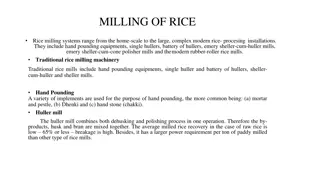The Fascinating World of Rice: History, Health Benefits, and Varieties
The history of rice spans cultures and millennia, with rice being a staple food for a significant portion of the world's population. It is grown in various regions worldwide, providing essential nutrients and energy. Whole grain rice offers numerous health benefits, such as being a rich source of carbohydrates, dietary fiber, and essential nutrients like B vitamins. The different types and varieties of rice cater to diverse tastes and culinary preferences, offering unique flavors and textures.
Download Presentation

Please find below an Image/Link to download the presentation.
The content on the website is provided AS IS for your information and personal use only. It may not be sold, licensed, or shared on other websites without obtaining consent from the author. Download presentation by click this link. If you encounter any issues during the download, it is possible that the publisher has removed the file from their server.
E N D
Presentation Transcript
ALL ABOUT RICE The history of rice is a long and fascinating journey that spans thousands of years and multiple cultures. Rice is a staple food for a significant portion of the world's population. Roughly fifty-percent of the world population, including almost all of East and Southeast Asia, is wholly dependent upon rice. The cultivated rice plant (Oryza sativa) is an annual grass that grows to about 4 feet in height. The leaves are long and flattened and the plant has a fibrous, broad root system. The panicle, or flower cluster, is made up of spikelet bearing flowers that produce the grain. More than 90 percent of the world s rice is grown in Asia, mainly China, India, Indonesia, and Bangladesh, with smaller amounts grown in Japan, Pakistan and other Southeast Asian countries. Rice is also cultivated in Europe, North and South America, and Australia. Other than a variety called upland rice, the rice plant is grown on submerged land in coastal plains, tidal deltas, and river basins of tropical and temperate regions. The seeds are sown into beds and after 25-50 days and then are transplanted to a field or paddy submerged in 2 to 4 inches of water where it will remain for the growing season. Successful rice production depends on quality soil, adequate irrigation and long periods of sunshine. Rice production yields can vary greatly but usually range from 600-3500 pounds per acre. Once harvested, the rice is milled to remove the hull and bran layers. Brown rice removes just the hull whereas white rice is milled to remove both the hull and bran. A coating of glucose and talc is sometimes applied to give the kernel a glossy finish before packaging. SEPTEMBER 2023 RICE ACF IOTM
HEALTHY INGREDIENT CONTRIBUTION Rice, particularly whole grain varieties, offers several health benefits due to its nutrient content and role in providing energy. However, it's important to note that the health benefits can vary depending on the type of rice consumed and the overall diet. Some of the potential health benefits include: Energy Source: Rice is a rich source of carbohydrates, which are the body's primary source of energy. It provides a quick and sustained energy release, making it an important part of a balanced diet, especially for individuals with high energy requirements, like athletes. Dietary Fiber: Brown rice and other whole grain rice varieties contain dietary fiber, which aids in digestion, helps maintain healthy cholesterol levels, and supports gut health. Fiber can also contribute to a feeling of fullness, which may help with weight management. Gluten-Free: Rice is naturally gluten-free, making it an excellent option for individuals with celiac disease or gluten sensitivity. Nutrient Content: Brown rice retains the bran and germ layers, which contain valuable nutrients such as B vitamins (thiamin, riboflavin, niacin), magnesium, and phosphorus. These nutrients play essential roles in metabolism, nerve function, bone health, and more. Low in Fat and Sodium: Rice is naturally low in fat and sodium, making it a heart-healthy option. Choosing whole grain varieties and cooking rice without adding excessive amounts of salt or butter can further enhance its health benefits. Nutritional Information/Values from USDA FoodData Central SEPTEMBER 2023 RICE ACF IOTM
TYPES AND VARIETIES Rice is a staple food that comes in various types and varieties, each with its own unique characteristics, flavors, and uses. The type of rice you choose can greatly impact the texture and taste of your dishes. Other Types and Varieties: Common Types and Varieties: Glutinous/Sticky Rice High starch content Savory or sweet dishes Wild Rice Nutty flavor Not rice but a grass seed Black/Forbidden Rice Nutty flavor, chewy texture Deep black or purplish Red Rice Nutty flavor, chewy texture Reddish hue Brown Rice Bran intact More nutritious White Rice Bran and germ removed Mild flavor, soft texture Fragrant Rice Unique aromas and flavors Long Grain Rice Basmati aromatic fragrance, elongated grains Jasmine aromatic fragrance, slightly sticky texture American less aromatic, fluffy texture Medium Grain Rice Arborio high starch content Calrose slightly sticky texture Short Grain Rice Japanese sticky texture, holds together Bomba absorbs liquids and flavors SEPTEMBER 2023 RICE ACF IOTM
Selecting and storing rice properly is important to maintain its quality, flavor, and nutritional value. SELECTING AND STORING Selecting Rice: Variety: Choose the type of rice that best suits your dish. Consider factors like texture, flavor, and aroma. Quality: Look for rice that is clean, free from foreign particles, and doesn t have any signs of insect infestation or damage. Packaging: Opt for rice that is well-packaged and sealed. If buying in bulk, ensure that the containers are airtight and properly sealed. Date: Check the production or best by date on the package to ensure freshness. Storing Rice: Cool and Dry Place: Store rice in a cool, dry place away from direct sunlight, moisture, and strong odors. Airtight Containers: Transfer rice to airtight containers or resealable bags to prevent moisture and pests from getting in. This is especially important for rice that comes in paper bags or less sturdy packaging. Keep Away from Heat: Avoid storing rice near sources of heat such as the range or oven, as heat can lead to spoilage. Avoid Freezing: While some rice can be frozen, it s generally not recommended due to potential changes in flavor and texture. Use Desiccants: Adding desiccant packets to the rice storage container can help absorb excess moisture and maintain dryness. Rotate Stock: If you buy rice in large quantities, use the oldest stock first to ensure the rice remains fresh. Whole Grain Rice: Whole grain varieties like brown and red rice have a higher oil content due to the bran layers. This can lead to quicker spoilage, so it s important to pay close attention to their storage. SEPTEMBER 2023 RICE ACF IOTM
CULINARY USES Rice is an incredibly versatile, low-cost ingredient with a wide range of culinary uses and is usually consumed with other nutrient-rich foods such as fruits, vegetables, legumes, nuts/seeds, poultry and lean meat. It serves as a staple food in many cultures and can be prepared in various ways to create dishes ranging from savory to sweet. Long-grain rice, which cooks light and fluffy with the kernels separated, is often used for making pilafs, stuffings, rice salads and jambalaya. Medium-grain rice is moist and tender and is commonly used for making paella and risotto. Short-grain rice, with its shorter, rounder kernels, becomes moist and sticky when cooked, making it a great option for rice puddings, desserts, and sushi. Ground rice, used to make rice flour, is a common ingredient in gluten-free baking, as well as for making rice noodles, rice paper, and other dishes. Fermented rice can be used to make vinegar and alcoholic beverages including rice wine, sake and soju. Rice milk, made by pressing rice through a millstream, is commonly used as a dairy substitute for vegan cooking and those avoiding dairy. SEPTEMBER 2023 RICE ACF IOTM
FUN FACTS Rice is one of the oldest cultivated grains, with a history that dates back over 10,000 years. There are over 40,000 varieties of rice, each with its own unique taste, texture, and color. In 1971, rice became the first grain to be grown in space when Apollo 14 astronauts carried rice seeds to the moon. The largest serving of fried rice weighed over 6,000 pounds and was achieved in China in 2014. In some Asian countries, rice paddies are used as canvases to create intricate artworks using different colored rice plants. Rice requires a significant amount of water to grow, often leading to the construction of elaborate irrigation systems in rice-growing regions. The International Rice Research Institute (IRRI) in the Philippines played a crucial role in developing high-yielding rice varieties, leading to the "Green Revolution" and increased food production. In some parts of ancient Asia, rice was used as a form of currency, and taxes were collected in rice. SEPTEMBER 2023 RICE ACF IOTM
RECIPE Vegetable Biryani Yield: 6 Servings Ingredients: Directions: 3 T. Ghee (or Clarified Butter) 1 Medium Yellow Onion, Diced 1 T. Garlic, Minced 1 T. Ginger, Minced 1 Roma Tomato, Minced C. Water C. Green Peas 1 Carrot, Sliced Thin 2 Russet Potatoes, Peeled & Diced 1 Green Pepper, Sliced 2 Stalks Celery, Sliced 1 C. Cauliflower Florets 2 t. Kosher Salt t. Cayenne Pepper t. Black Pepper 2 t. Garam Masala 1 t. Coriander t. Turmeric 1 t. Cumin t. Cinnamon 4 C. Vegetable Stock 2 C. Basmati Rice, Rinsed & Drained 1. 2. 3. Add ghee into a large Dutch oven over medium-high heat. Add the onion and cook until translucent, about 3-4 minutes. Stir in garlic, ginger, tomato, and water. Bring to a simmer and cook until the water has evaporated, about 10 minutes. Add in the peas, carrot, potato, green pepper, celery, and cauliflower. Mix well to combine. Add in the salt, cayenne, black pepper, garam masala, coriander, turmeric, cumin, and cinnamon. Stir well to blend spices. Add in the vegetable stock and bring to a boil. Add in the rinsed and drained basmati rice. Reduce the heat to low and cook covered for 18-20 minutes. Turn off the heat and let sit, covered, for five minutes before serving. 4. 5. 6. 7. 8. 9. SEPTEMBER 2023 RICE ACF IOTM
QUIZ After you read through this month s Ingredient of the Month, take this quiz to test your knowledge. In order to earn continuing education hours (CEHs) from the American Culinary Federation (ACF), the test must be completed through the ACF s Online Learning Center. Seventy-five percent accuracy is required to earn one hour of continuing education credits toward professional certification. SEPTEMBER 2023 RICE ACF IOTM
QUIZ Question #1 More than 90 percent of the world s rice is grown in Japan and Pakistan. A. True B. False SEPTEMBER 2023 RICE ACF IOTM
QUIZ Question #2 What is rice sometimes coated with to give it a glossy finish? A. Cornstarch and talc B. Sucrose and talc C. Arrowroot starch and talc D. Glucose and talc SEPTEMBER 2023 RICE ACF IOTM
QUIZ Question #3 Rice is a rich source of _____, which are the body s primary source of energy. A. gluten B. carbohydrates C. fiber D. magnesium SEPTEMBER 2023 RICE ACF IOTM
QUIZ Question #4 Which type of rice has a mild flavor, soft texture, and has had both the bran and germ removed? A. White B. Brown C. Red D. Black SEPTEMBER 2023 RICE ACF IOTM
QUIZ Question #5 Jasmine rice has a _____ texture and is _____ fragrant than American rice. A. slightly sticky; less B. fluffy; more C. slightly sticky; more D. fluffy; less SEPTEMBER 2023 RICE ACF IOTM
QUIZ Question #6 Which type of rice is commonly used to make paella and risotto? A. Glutinous B. Short-grain C. Medium-grain D. Long-grain SEPTEMBER 2023 RICE ACF IOTM
QUIZ Question #7 Fermented rice is used to make which of the following? A. Kombucha B. Soju C. Sake D. Both B and C SEPTEMBER 2023 RICE ACF IOTM
QUIZ Question #8 Which institute played a crucial role in the development of high- yielding rice varieties, contributing to the Green Revolution ? A. IRRI B. NASA C. WHO D. UNICEF SEPTEMBER 2023 RICE ACF IOTM
QUIZ Question #9 How are rice paddies creatively used in some Asian countries? A. As swimming pools B. As farms for livestock C. To create intricate works of art D. For building houses SEPTEMBER 2023 RICE ACF IOTM
QUIZ Question #10 What type of rice is used in the recipe for Vegetable Biryani? A. American B. Basmati C. Bomba D. Jasmine SEPTEMBER 2023 RICE ACF IOTM
JOIN US NEXT MONTH! Stay tuned for the next ACF Ingredient of the Month! Be sure to visit the Online Learning Center (OLC) to download a copy of each month s ingredient presentation. Don t forget to take the official IOTM quiz through the OLC to earn one hour of continuing education credits toward professional certification. For more information: www.acfchefs.org www.acfchefs.org/olc www.acfchefs.org/iotm SEPTEMBER 2023 RICE ACF IOTM























